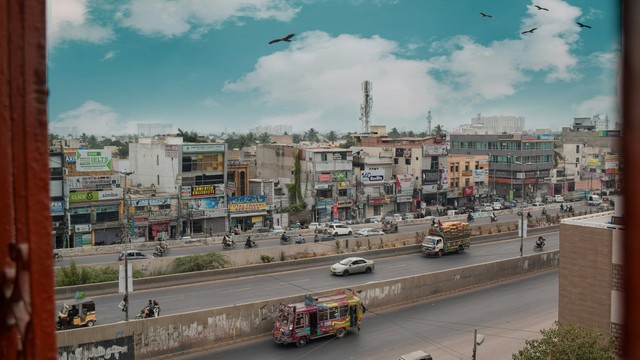Making Indian cities inclusive means making them more walkable
Walking, cycling and using public transport are the main ways of getting around Indian cities. But as India's cities expand and car ownership increases, pedestrians are being marginalised – and their safety is being put at risk.



In many Indian cities pedestrians are forced to share the road space with motorbikes and cars (Photo: Christine Ro/IIED)
In dimly lit parts of Bengaluru, India, placing a foot wrong on an evening stroll can lead to a nasty fall into a pothole. Walkability – the ability of pedestrians to move around an area easily, safely, and smoothly – remains terrible, even close to sensitive areas like schools or hospitals. For people with mobility issues and wheelchair users, the situation is even worse.
Being able to walk down the street is something that many take for granted. But incidents such as the recent death of a five-year-old outside her school in Kolkata are making some people nervous about walking around Indian cities, though this remains the most common mode of transport.
Roads in Indian cities are getting less safe
In the last few decades, India’s urban population has grown rapidly. Without suitable policies and infrastructure to manage growth, this has resulted in urban sprawl and traffic congestion, made worse by inadequate quality and safety of public transport and non-motorised transport infrastructure. Mobility in urban India is in transition – with people travelling longer distances and more frequently, but using non-motorised and public transport less.
Compared to other countries, India’s vehicle ownership remains fairly low, at 13 cars per 1000 persons (PDF). But the negative effects of increased vehicle use are glaring: in 2016, road traffic incidents were the ninth most common cause of premature deaths in India.
According to data in Urban India 2015: Evidence, a publication by the Indian Institute for Human Settlements (IIHS), India had the highest number of road deaths (around 130,000) among 182 countries in 2010. Collisions were nearly double those in China and around four times those in the United States. On average, 56 pedestrians died every day, according to data released by the government in 2017.
Urban India 2015: Evidence also highlights that, unsurprisingly, crashes are more frequent in larger, crowded cities. In 2013, just six cities – Mumbai, Chennai, Indore, Delhi, Bengaluru and Kolkata – contributed to a quarter of all urban road accidents.
Poor planning for pedestrians especially hurts those on low incomes
Pedestrians and bicyclists are often the most vulnerable. According to a paper titled ‘Urban Transport in India – Challenges and Recommendations’, published by IIHS in 2015, pedestrians account for more than 40% of road traffic fatalities in New Delhi, Bengaluru and Kolkata. Bengaluru fares the worst, with three pedestrians killed on roads every two days, and more than 10,000 hospitalised annually.
The urban poor are often ‘captive users’ of non-motorised transport. They walk or cycle even when it’s inconvenient, because they can’t afford any other modes of transport. As a result, unsafe roads overwhelmingly affect socially and economically disadvantaged residents.
Marginalised communities such as poor people and migrants are also unduly affected by collisions, as they’re often in more vulnerable positions as pedestrians or users of non-motorised transport. They also potentially lack good access to medical and trauma care.
Making cities safer for pedestrians
Indian cities must address these issues and improve pedestrian and bicycle infrastructure. In most Indian cities, barely 30% of streets have pedestrian pathways. Even where pedestrian paths exist, they’re often taken over for parking or sometimes even driving of motorised vehicles, especially ‘two-wheelers’ ubiquitous in many Indian cities.
Road space is unequally distributed because streets in India aren’t being designed to accommodate all the functions of a street, a fact that some new policies are now trying to change.
Chennai, for example, has drafted non-motorised transport policies (PDF) to create footpaths along 80% of its streets, along with infrastructure such as cycle lanes, with the promise that they will begin prioritising people over vehicles. While moving from policy to implementation is a slow journey, such policies are gradually turning the focus on walking and cycling.
Better enforcement of traffic laws is also crucial. This needs to benefit the people most endangered by traffic violations. Reports of speeding SUVs hitting auto rickshaws and pedestrians continue to be common, with low-income road users being the most affected.
Despite this, pedestrians or cyclists are sometimes made to bear the burden of traffic regulation. Pedestrians are regularly urged to use footbridges or skywalks (elevated walkways) in the absence of pedestrian crossings. But many cases have shown that this is a less than effective solution. Wheelchair users, for one, are completely ignored in these designs.
In Mumbai, more than 30 skywalks have been built since 2008. But these have come under fire for being very expensive to build and difficult to use, given the lack of escalators or lifts and limited considerations of safety.
Some individuals have taken matters into their own hands. Gangadhara Tilak Katnam is a 70-year-old resident of Hyderabad who quit his job to repair potholes full-time under his own steam. He’s filled more than 1,300 potholes so far, and he’s not the only vigilante pothole-fixer in an Indian city.
But individual solutions can’t replace sustained governmental action. Indian cities need better coordination between agencies that can holistically take responsibility for transport, including generating reliable transport data.
As Indian mobility continues to transform, this is a prime time to determine its future course. Do we want cities that cater largely to affluent and polluting motorists, or cities that are welcoming to all types of road users?






